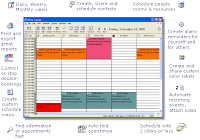 In a prior post, I talked about how the most powerful time management system is one that a user designs for themselves. When users know the principles behind a good system they are much better equipped to design a unique approach that works for them.
In a prior post, I talked about how the most powerful time management system is one that a user designs for themselves. When users know the principles behind a good system they are much better equipped to design a unique approach that works for them.
One area that is often misunderstood is the use of a calendar in an overall time management system.
I have observed that people use calendars in ways that are unproductive, because they are stuck in an old paradigm of the Appointment Calendar. The Appointment Calendar probably originated with the kind of calendar used in a doctor’s office. It was a tool the receptionist used to ensure that different patients were not being scheduled at the same time. Continue reading “Ways to Use a Calendar v2”


 Often, critical information enters a capture point that needs to be stored for later use. It may come as part of a time demand, such as a note placed on our desk that says “Call Suzie tomorrow at 555-1616.” This particular note has both a time demand plus a critical piece of information.
Often, critical information enters a capture point that needs to be stored for later use. It may come as part of a time demand, such as a note placed on our desk that says “Call Suzie tomorrow at 555-1616.” This particular note has both a time demand plus a critical piece of information. During the act of
During the act of  Tossing is one of the components that can directly follow
Tossing is one of the components that can directly follow 



